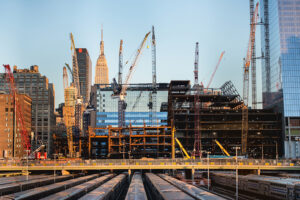Protecting the Public from Construction Hazards
By Scott Fowler, Contributor

In updating the standard, the A10.34 subcommittee places greater emphasis on preparing an emergency action plan. Image courtesy of ASSP
Construction safety goes beyond protecting workers. You also have to protect the public. Construction projects happen in different environments, and you have to consider the people and property in those environments and how the work may impact them.
The recently updated ANSI/ASSP A10.34-2021 standard provides best practices for protecting the public on or adjacent to construction sites, and identifies different construction hazards that can endanger the people, property, and environment surrounding the job site.
Each project has a set of challenges that vary in terms of the type of public space, occupants, and potential impacts to property. A hazard assessment is an effective tool for protecting the public from activity on the job site, and workers on the job site from intrusion by the public.
This edition of A10.34 includes key updates that provide greater detail and clarity on how to protect the public on construction sites.
Greater Focus on Hazards
In updating the standard, the A10.34 subcommittee placed greater focus on certain construction hazards and provided additional guidance on how to properly address them to keep the public safe.
Sections on falls/falling objects and run-over/back-over were improved to include not only additional fall protection options for people and property below work activities, but also new requirements for tool tethering and greater detail on effective run-over/back-over practices.
Other new sections address hazards and environments, including:
- Scaffolding
- Excavations
- Explosives
- Fire prevention
- Severe weather
- Utility avoidance
- Marine operations
Planning for Emergencies

Each construction project has a set of challenges that vary in terms of the type of public space, occupants, and potential impacts to property. Image courtesy of ASSP
The updated version also places greater emphasis on preparing an emergency action plan. A10.34 requires that measures be established to restrict public access to the job site.
An emergency action plan consists of four key elements:
Security: Site management should enact measures to restrict public access to the job site. If this is not practical, site management should take steps to lock, barricade, or remove equipment, supplies, or materials that pose a hazard.
Injuries/Damage: Any observed injuries or damage to the public must be immediately assessed for severity and investigated, and immediate action to minimize further injury or damage and to secure medical help for those injured.
Public Protest: The plan should define how the site will respond when members of the public purposely place themselves or others at risk by failing to observe or heed warnings, directives, or safety precautions.
Threats: The plan should also describe how to communicate bomb threats or other violence to the job site and include immediate notification to and interfacing with authorities.
A10.34-2021 provides a public hazard control plan template to help you identify hazards, describe the actions taken and assign responsibilities for reducing and eliminating the hazards identified.
The template includes examples of common hazards encountered over the course of a construction project, including noise, vibration, radiation, and falling objects. You can also use this tool to identify those responsible for different aspects of the construction project, provide contact information for local utilities and emergency response authorities, and list those authorized to access the job site after hours.
Download a free copy of the public hazard control plan template to use at your work sites. CS
Scott Fowler is the Content Specialist at the American Society of Safety Professionals (ASSP; www.assp.org).



